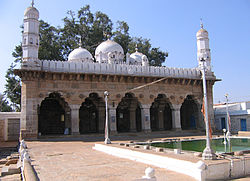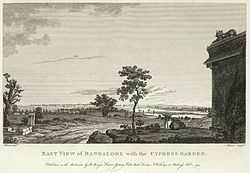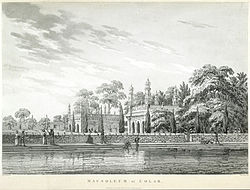Sira Subah
| Subahof Sira | |||||||||
|---|---|---|---|---|---|---|---|---|---|
| SubdivisionofMughal Empire | |||||||||
| 1687 - 1766 | |||||||||
|
Alam flag of the Mughal Empire | |||||||||
 Mughal province of Sira shown in a map of South India at the time of the Anglo-French Wars in the Carnatic, 1746–1760 | |||||||||
| Capital | Sira | ||||||||
| Legislature | Mughal Darbar | ||||||||
| Historical era | Early-modern period | ||||||||
• Established | 1687 | ||||||||
• Disestablished | 1766 | ||||||||
| |||||||||
| Today part of | India | ||||||||
TheProvince of Sira,also known asCarnatic-Balaghat,was asubah(imperial first-level province) of theMughal empireinSouth Indiathat was established in 1687 by conquering emperorAurangzeb(likeBijapurin 1686 andGolkondain 1687) and lasted until 1757. The province, which comprised theCarnatic regionsouth of theTungabhadra river,[1]had its capital in the town ofSira.[2]It was composed of sevenparganas(districts):Basavapatna,Budihal,Sira,Penukonda,Dod-Ballapur,HoskoteandKolar;in addition,Harpanahalli,Kondarpi,Anegundi,Bednur,ChitaldroogandMysorewere considered by the Mughals to be tributary states of the province.[3]
History
[edit]After theMughalarmies overran the region of theMysore plateau,12parganaswere annexed to the newly formed province (subah) of Sira.[4]The remaining region was allowed to remain under the rule of thePalaiyakkarars (Polygars),who were required to pay tribute to the provincial government in Sira.[4]
In 1757, Sira was overrun by the Marathas, only to be restored to the Mughals again in 1759.[5]Two years later,Haidar Ali,whose own father had been the Mughal military governor (orFaujdar) ofKolar districtin the province, captured Sira, and soon conferred on himself the title of "Nawab of Sira."[5]However, the defection of his brother, a military governor, in 1766 caused the province to be lost again to the Marathas. In 1767,Madhavrao Iorganized a 2nd expedition againstHyder Aliand inflicted defeats onHyder Aliin the battles ofSiraandMadhugiriand absorbed Sira subah intoMaratha confederacy.who retained it until Haidar's son,Tipu Sultan,recaptured the area for his father in 1774.[5]
Subahdars (governors)
[edit]Qasim Khan (also, Khasim Khan or Kasim Khan) was appointed the firstSubahdar(governor) of the province in 1686.[5]After successfully "regulating and improving" the province for eight years, he died in 1694 under mysterious circumstances, either during an assault byMaratharaiders,[5]or by his own hand in disgrace after the raiders seized a treasure in his care.[6]Mostsubahdarswho came after him lasted only a year or two,[5]and the frequent changes at the helm continued until the appointment of Dilavar Khan in 1726, whose term, which lasted until 1756, finally brought some stability to the province.[5]
| ||||||||||||||||||||||||||||||||||||||||
Administration
[edit]
In the annexed regions, in which tax assessment on cultivation was underamāniorSarkār(i.e.provincial government) management, several types of officers collected and managed revenue.[4]Most offices had existed in the region under the previousBijapur Sultanateadministration, and consisted, among others, ofDeshmūks,Deshpāndes,Majmūndārs,andKānungoyas.[4]TheDeshmūks"settled accounts" with the village headmen (orpatels[8]); theDeshpāndesverified the account-books of the village registrars (orkārnāms[8]); theKānungoyasentered the official regulations in the village record-books and also explained decrees and regulations to the village governing officers and residents.[4] Lastly, theMajmūndārsprepared the final documents of the "settlement" (i.e.the assessment and payment of tax) and promulgated it.[4]
Until the mid-seventeenth century, both villagers- and district (taluq) accounts had been prepared in the language and script ofKannada,the region's traditional language.[9] However, after the Bijapur invasions,Marathachieftainscame to wield authority in the region and brought in with them various officials who introduced theMarathi languageand script into the "public accounts."[9]The new language found its way even into lands ruled by somePalaiyakkarars (Polygars)chiefs.[9]These chieftains had brought inMarathi-speaking horsemen from the northern Bijapur realms for their newly formed cavalry units; consequently, they resorted to hiring Maratha accountants for the benefit of these cavalrymen.[9]After the province of Sira was created, the official language of theMughal empire,Persian,came to be used.[9]
The capital and its monuments
[edit]
The capital of the province, Sira town, too, prospered most under Dilavar Khan and expanded in size to accommodate 50,000 homes.[1]Palaces and public monuments of Sira became models for other edifices.[1]Both Haidar Ali's palace in Bangalore and Tipu Sultan's in Seringapatam were modeled after Dilavar Khan's palace in Sira.[1]Moreover, according to the (Imperial Gazetteer of India: Provincial Series 1908), Bangalore'sLal Baghas well asBangalore fortmay have been designed after Sira's Khan Bagh gardens and Sira fort respectively.[1]Sira's civil servants, however, could not be as readily reproduced: after Tipu Sultan had succeeded his father as Sultan of Mysore in 1782, he deported 12,000 families, mainly of city officials, from Sira to Shahr Ganjam, a new capital he founded on Seringapatam island.[1]
There are Mughal-era buildings that still stand in the town. Among them are the Juma Masjid in Sira.
The other towns
[edit]
Different towns and regions fared differently during the eventful seventy-year history of the province. InBangalore district,for example,Bangalore townwas sold to the WadiyarRaja of Mysore forRs.300,000.[10]The rest of the district was divided in the following fashion: the north was made a part ofChik Ballapur,other parts were added toSirataluk(district), and the remainder, which included the town ofDod Ballapur,was constituted into ajagir.[10]This was first gifted to a general named A. H. Khuli Khan, who, however, died shortly thereafter.[10]Thejagir,which was to yield an annual revenue of 54,000pagodas,then passed on to his son, Darga Khuli Khan thesubahdarof Sira during 1714–1715, who too retained it for a mere year.[10]It was then "attached to the government of Sira" for 49 years until it was seized by theNizam-ul-Mulkof Hyderabad, and eventually captured by Haidar Ali.[10]
See also
[edit]Notes
[edit]- ^abcdefImperial Gazetteer of India: Provincial Series 1908,pp. 175–176
- ^Imperial Gazetteer of India: Provincial Series 1908,p. 166
- ^Imperial Gazetteer of India: Provincial Series 1908,p. 19
- ^abcdefRice 1897a,p. 589
- ^abcdefgRice 1897b,p. 166
- ^Rice 1897b,p. 521
- ^Imperial Gazetteer of India vol. IV 1907,p. 335
- ^abRice 1897a,pp. 574–575
- ^abcdeRice 1897a,pp. 589–590
- ^abcdeRice 1897b,pp. 68–70
References
[edit]- Imperial Gazetteer of India: Provincial Series (1908),Mysore and Coorg,Calcutta: Superintendent of Government Printing. Pp. xvii, 365, 1 map.
- Rice, Lewis(1897a),Mysore: A Gazetteer Compiled for the Government, Volume I, Mysore In General,Westminster: Archibald Constable and Company. Pp. xix, 834
- Rice, Lewis(1897b),Mysore: A Gazetteer Compiled for the Government, Volume II, Mysore, By Districts,Westminster: Archibald Constable and Company. Pp. xii, 581

